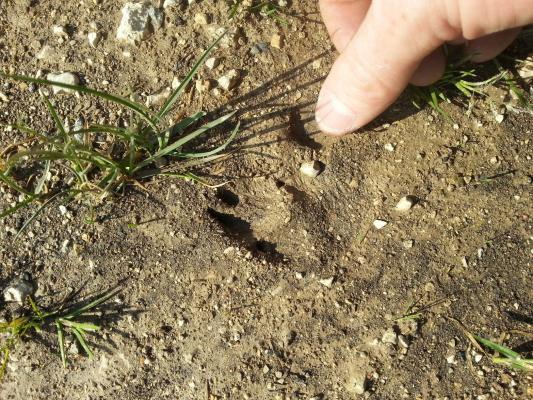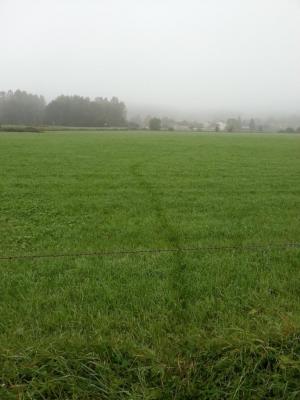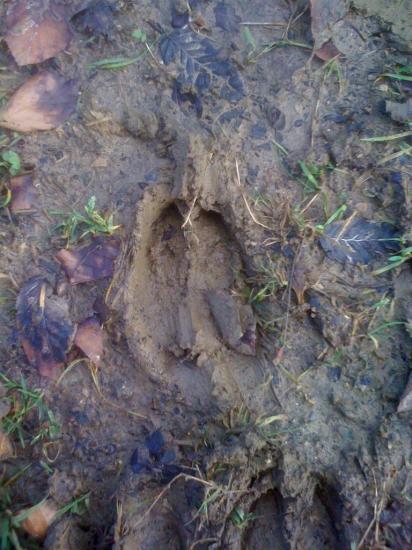Déterminer l'âge d'une empreinte : utopie ou réalité ?
- Par pisteur
- Le 20/04/2013
- Dans Conseils et astuces / Tips and tricks
Aging tracks, utopia or reality?

If aging prints proves difficult by a simple visual inspection, how can we determine the age of the track?
Aging by cross-referencing, useful chronological information
Rien de tel qu'une couche de neige fraîche tombée durant la nuit pour repérer les déplacements nocturnes des animaux, il est alors très facile de determiner l'âge d'un pas dans ce médium excepectionnel et providentiel. L'âge d'une empreinte dans la neige peut être évalué en tapotant le fond de cette dernière pour voir si elle a conservé ses propriétés cristallines ou si au contraire elle a gelé. On peut également souffler fortement pour vérifier la mobilité des cristaux au fonds de l'empreinte. Comme pour le sable, de petites craquelures peuvent également apparaître sur le pourtour d'une trace fraîche.
There's nothing like a layer of soft, new fallen snow to observe the nocturnal movements of animals, as it is then very easy to age a footprint on this providential medium. The freshness of the print can be estimated by feeling the bottom of the print to see if the crystals are soft to the touch or frozen from the night before. You can also blow hard on the bottom of the track to check the crystal’s mobility ; if the crystals fly in the air the track is quite fresh. While examining prints in the sand, you can look for little cracks which may appear on the edge of a fresh print.
Those who follow the same path everyday will notice the trail of a group of wild boars or a herd of deer in the fields, and therefore can estimate the time of their passage. Another thing to note is that no animal will cross a frosted or dewy field without leaving a conspicuous trail. Some nocturnal animals can be used as chronological markers. A badger's footprint overlapping another print dates back at least from the night before, as this big mustelid only goes out at night
Taking account of weather changes
Rain, for example, leaves clear marks on the surface of a sandy soil giving the track a pockmarked aspect. If the bottom of the print does not have that pockmarked character, the track might have been made before the rainy spell. Plant debris can also collect in a track after a storm.
The leaf in the top track shows the lack of freshness of the print
Spider webs are good chronological markers.
Here's one in a roe deer track
Just keep in mind that it does not take long
for an arachnid to build its web, and
its chemical composition makes it particularly durable.
Therefore, look for additional elements
that would help to date its construction
such as tree seeds, leaves, bird feathers or dew.
- L'aspect des arrêtes
- La couleur du fond de la dépression créée par les doigts : est-elle identique à celle de l'empreinte ? celui-ci apparaîtra plus sombre sur une empreinte récente.
- Si à côté d'une trace profonde le doigt s'enfonce avec difficulté, il est possible que le medium soit devenu plus dur en séchant et donc que la trace soit ancienne
A great trick for aging a track is to put your finger in the dirt as close as possible to the print. By pressing the finger into the mud, you can try to create a depression of similar depth. Then pay attention to :
-
The aspect of the edges
-
The color of the floor of the track. Is the color the same as the print?
-
If the finger does not sink as deep as for the print, the medium may have changed its constitution by drying and therefore the print is relatively old.

Ne pas être trop focalisé par les traces elles-mêmes nous permet parfois de trouver des indices supplémentaires concernant l'âge de la piste. L'émanation entêtante laissée par les glandes métacarpiennes du sanglier, l’odeur chevaline du cerf, nous renseignent sur la proximité de ces animaux lorsque nous les pistons. On cherchera également la présence de brisées fraîches (une brisée récente dégage une forte odeur de sève pendant quelques heures), de flaque d’eau ou d’empreinte remplie d’eau trouble (les sédiments floculent au fond d’une flaque en moins d’une heure).
Not being too focused on the tracks themselves sometimes allows us to find extra clues regarding the age of the trail. Some animals have an olfactory signature particularly obvious. The heady scent left by the metacarpial glands of a boar or the horse-like smell of a stag are signs that we are about to catch up with these animals when we track them. Search for freshly broken branches which should give off a strong smell of sap for a few hours. Puddles or prints filled with cloudy waters means that the animal may have been there recently as sediments settle at the bottom of a puddle in less than an hour.

Eau troublée par le passage récent des animaux
(une pluie forte peut produire un résultat similaire)
Il faut en général moins d'une heure pour que l'eau
retrouve sa limpidité.
Water disturbed by the recent passage of animals
(a similar result is possible with a heavy rain).
It usually takes one hour until the water is clear again.

Un transfert d’eau, sur la terre sèche autour d'un point d'eau
signale toujours un passage ou un départ récent.
Fresh water splashes on the ground
close to water are the sign
of a passage or a recent departure

Boue déposée par un sanglier
sur un arbre renversé.
La faire rouler entre le pouve et l'index
permet d'en apprécier la fraicheur.
Mud deposited by a wild boar
on a downed tree
You can appreciate its freshness
by rolling it
between thumb and forefinger

Des marques vert-sombre peuvent apparaître sur la végétation piétinée.
Ces blessures, situées le plus souvent au dos des feuilles, jaunissement en quelques heures.
Dark-green marks may appear on trampled vegetation
These scars located on the underside of the leaves
turn yellow in a few hours.

20 à 30 minutes sont nécessaires aux ouvrières,
pour abriter leurs larves lors de l’éventration d’une fourmilière.
Une information importante, lorsqu'on cherche à estimer l'âge du piétinement.
It can take 20-30 minutes for worker ants
to shelter their larvae after their anthill has been ripped open.
An information to take into consideration
when trying to age a trampling situation.
Bauge de sanglier.
Boar's bed
Pour savoir si un animal vient juste de quitter sa couchette, on évalue la température de cette dernière en posant la main au fond de la dépression. Cette chaleur résiduelle est plus difficile à ressentir chez les cervidés dont le poil creux possède un fort pouvoir insolant (même juste après le départ de l’animal). Sans être réellement chaud, l’endroit où le cervidé était couchait restera toutefois moins froid que le sol environnant.
To find out if an animal just left its bed, the temperature of the resting place can be taken by laying the back of the hand on the bottom of the depression. If the animal was there recently this area, while not necessarily being cold, will be warmer than the surrounding area. However, this residual heat is harder to feel with cervids whose hollow hair provides high insulation (even right after the animals' departure or flight).

Savoir reconnaître un frottis récent (ici un brocard)
Une blessure très fraîche sur un rameau est verdâtre,
la sève mouille encore le doigt et dégage une forte odeur.
Knowing how to recognize a fresh rub (here a roe buck)
A fresh wound on a branch is greenish
The sap still wets the finger and emits
a strong odor.
Cette mousse encore figée par la gelée matinale
garde une impression quasi-parfaite de cette trace humaine.
This moss still solidified
by the morning frost
keeps a near-perfect impression
of that human print
Quelques exemples de vieillissement
A few examples of ageings
Empreintes de botte / Boot prints
A droite, aspect de l'empreinte après une heure de pluie battante
A gauche l'impression récente comme référence.
On the right, aspect of the track after an hour of pouring rain.
On the left, recent impression for reference.
 Les rosées nocturnes durcissent
Les rosées nocturnes durcissent
la surface du sable,
Les traces du matin sont alors entourées de
craquelures très caractéristiques,
qui n'apparaissent pas sur celles de la veille.
Night dews harden
the surface of the sand
The morning prints are
then enclosed by characteristic cracks
that do not appear
on those of the previous day









